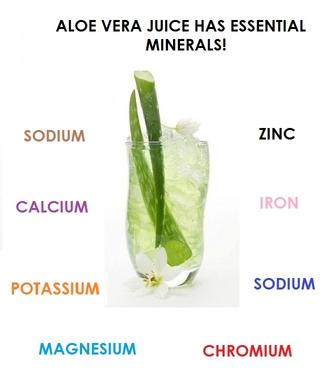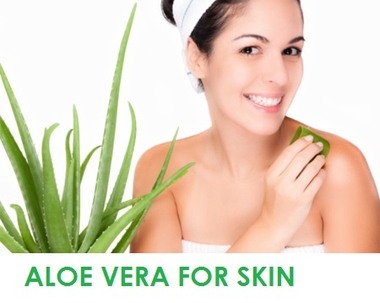Did you know aloe vera can help clear up acne? Or that the oral administration (i.e. aloe juice) of aloe vera may be a useful adjunct for lowering blood sugar in diabetic patients? It may even help prevent certain illnesses due to its incredible antioxidant activity.
When we think of aloe vera, the first thing that usually comes to our minds is using it to sooth and heal sun burns. However, these juicy, nutrient-rich plants are used all across the world in a variety of applications that can do wonders for your health. This makes complete sense when you learn that the plant contains over 75 different nutrients, vitamins, minerals, enzymes, sugars, phenolic compounds, amino acids, and so much more goodness for our health.
Below is a list of the ten benefits of aloe vera that you probably did not know about:
1. Preventing Illness
Aloe Vera plants contain surprisingly high levels of antioxidants. Antioxidants fight free radicals (highly unstable, reactive molecules responsible for aging and cellular damage) in your body, neutralizing them and preventing those cells from exacerbating into diseases such as cancer.
Did you ever think that the age of your aloe vera plant would impact its effectiveness on your health? One very interesting study out of China found that the older the aloe vera plant (Aloe Barbadensis), the stronger the antioxidant/free radical scavenging activity! Specifically, the study found that three-year-old aloe vera extract exhibited the strongest radical scavenging activity of 72.19%, compared to two-year-old and four-year-old counterparts that were also tested (1). Basically, it suggests that Aloe Vera contains different active components and antioxidant active components to different degrees at various stages of development. So make sure to keep you aloe plant for a few years for optimal health benefits.
2. Aids In Digestion
Aloe Vera contains eight specific enzymes that do miracles for digestion. Specifically, the enzymes contained in aloe vera help the breakdown of food sugars and fats, which ultimately aid digestion and enhance nutrient absorption. Some of these enzymes are called lipases and proteases, and their job is to break down foods and aid digestion.
3. Contains Essential Amino Acids
Did you know that aloe vera contains 19 of the 20 natural amino acids required by the human body? Naturally, our bodies only produce 12 of these essential amino acids. The remaining 8 amino acids (also known as “essential amino” acids) have to be consumed via food or drink. So next time you see an “aloe vera” drink in the store, it may not be a bad idea to have one now and again.
4. Aids In Glowing Skin
We have all heard of the miracles of “mineral makeup” by now, but you probably never would have thought that aloe contains 10 of the most important minerals for your skin {and it’s much cheaper than mineral makeup!}. The key minerals include calcium, chromium, copper, iron, magnesium, manganese, potassium, phosphorous, sodium and zinc. So it may not be a bad idea to put aloe vera gel/extract on your face before bed to get that fresh, lovely glow in the morning.
5. Helps Cure Acne
As previously mentioned, aloe contains an array of minerals, one of which is zinc. Zinc us often found in many natural vitamins and skin care products for improving blemishes. Applying aloe both topically and taking it orally can help with your acne. Zinc reduces the amount of natural oil, or sebum, produced in the skin. It may also help heal damaged skin around the acne that develops. Some research even suggests that acne formation is a result in part from lack of zinc in the diet.
6. Reduces Pain
Aloe Vera contains many enzymes (proteins), but one in particular is responsible for helping reduce pain. Its name is kinase, and it specifically helps reduce excessive inflammation when applied to the skin to reduce pain. There are other enzymes in aloe as well that digest all of the dead tissue in your wound, leaving more space for healing, but kinase is the most well known.
7. Repairs Skin During Frostbite
There’s nothing worse than having a direct or indirect injury from frostbite. Overall, there are four stages of frost bite; (A) numbness and redness of the skin (B) swelling, ice formation, blisters, and release of a chemical called “thromboxsne” (pain releasing chemical and blood vessel constrictor) (C) damage extends to the subdermis (deepest layer of skin that attaches bone to skin, and supplies muscle tissue with blood vessels and nerves) (D) full tissue thickness resulting in blood loss and even gangrene. (2).Overall, aloe has been suggested to reduce the level of “thromboxane” (i.e. pain) and has been used clinically on this assumption to treat the more severe blisters where there is structural damage (3,4).
One interesting clinical trial study found that topical application of aloe vera cream to humans resulted in a 68% full recovery for patients with tissue damage. Contrarily, only 33% of other patients fully healed that received other forms of treatments for tissue cellular damage from frostbite. Another shocking result from this study was that in the first group only 7% required an amputation, compared with the 33% in the second group (5).
8. Anti-Cancer Activity
We all know aloe’s incredible ability to heal wounds, reduce pain and help clear skin, but did you know some researchers have found it to be an incredible active agent for tumor prevention? Although the research is still not complete as to whether or not aloe actually suppresses cancer, one study and set of results from Japan really stood out (6). The study surveyed a large group of lung cancer and smoking patients in Japan and found that the ingestion of aloe ‘juice’, presumably the gel, prevented pulmonary carcinogenesis (cancer in respiratory area) and was said to also prevent stomach and colon cancer (6).
9. Hair Growth
Aloe Vera activates new hair growth along with the growth of already existing hair follicles by increasing the blood circulation to the scalp. Aloe Vera contains a kind of enzyme that helps in new hair growth for some people. It also cleanses the scalp by balancing the pH level of the scalp. When the scalp is clean and blood circulation to the scalp is good, nothing can stop the proper and faster hair growth.
10. Reduces Blood Sugar
Diabetes is a disorder of carbohydrate metabolism characterized by a lowered insulin secretion (i.e. your body’s pancreas has a hard time converting sugar into energy). However, the causes, symptoms and treatments are varied and need to be carefully distinguished. However, one interesting study really stood out and deemed aloe useful for diabetes sufferers, or those who have trouble controlling sugar cravings/blood sugar. The study involved over 3000 “mildly” diabetic Indian patients and found a reduction in blood sugar levels in 90% of the cases after the patients were fed with bread that had incorporated aloe gel (7).
Decreased wound healing is also a common symptom associated with diabetes. Aloe vera gel has even been found to have great inflammation-reducing properties in chemically induced diabetic mice {pretty cool!}. In a later trial, both excision and incision wounds in chemically induced diabetic rats healed more rapidly after both oral or topical applications of aloe gel when compared to another traditional chemical used for wound reduction in diabetics. (8)
As you can now see, aloe vera plants pack a lot of benefits in their skinny little leafs. Refreshing, cleansing, healing, invigorating and detoxifying, aloe vera can make a great addition to your home life and improve your health.
References
(1) Yun, H., Juan, X., and Qiuhui, H., 2003. Evaluation of Antioxidant Potential of Aloe Vera (Aloe barbadensis Miller) Extract. Journal of Agricultural and Food Chemistry 51 (26), 7788-7791.
(2) McCauley, R.L., Heggers, J.P., Robson, M.C., 1990. Frostbite. Methods to minimize tissue loss. Postgraduate Medicine 88, 73-77.
(3) Raine, T.J., London, M.D., Goluch, L., Heggers, J.P., Robson, M.C., 1980. Antiprostaglandins and antithromboxanes for treatment of frostbite. American College of Surgeons 1980 Surgical Forum 31, 557-559.
(4) McCauley, R.L., Hing, D.N., Robson, M.C., Heggers, J.P, 1983. Frostbite injuries: a rational approach based on the pathophysiology. Journal of Tramua 23, 143-147.
(5) Heggers, J.O., Pilllips, L.G., McCauley, R.L., Robson, M.C., 1990. Frostbite: experimental and clinical evaluations of treatment. Journal of Wilderness Medicine 1, 27-32.
(6) Sakai, R., 1989. Epidemiologic survey on lunch cancer with respect to cigarette smoking and plant diet. Japanese Journal of Cancer Research 80, 513-520.
(7) Agarwal, O.P., 1985. Prevention of atheromatous heart disease. Angiology 36, 485-492.
(8) Davis, R.H., Maro, N.P., 1989. Aloe vera and gibberllin. Anti inflammatory activity in diabetes. Journal of the American Podiatric Medical Association 79, 24-26.














































